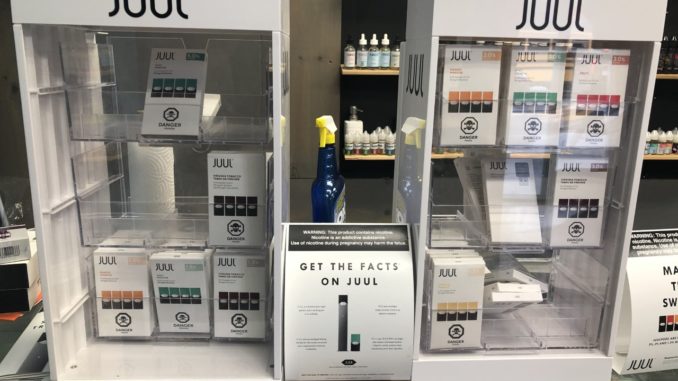
The doors of the vaping store in Richmond Hill north of Toronto are locked. Customers are screened before the store manager lets them in. If they look too young and don’t have a photo ID, they are not allowed in. Inside there are glass shelves with various vaping devices and products on display. A few people are sitting on the sofa and chatting. All the people who are inside are vaping, including the sales team and the manager.
The owner of the store, Dmitry, [not his real name], agreed to let us take pictures of the vaping products under very strict conditions. No mention of the store’s name or the address, no names at all. When we are done with the photos and about to leave, suddenly, Dmitry gets very emotional.
“So you’re writing about vaping? What do you know about it? All the stories about health damages and illnesses, its bullshit. Don’t listen to all these experts, that telling you the opposite. We have been in this market for 5 years; I know what I am talking about! Yes, a lot of young people are buying it. That’s because of their age, they want to try different things. There is also a social element. Young people want to belong, so they go smoking or vaping because everyone else is doing it. All our products have been tested in the independent lab. They are not harmful. But some people, after they read articles about death and illnesses from vaping, they come back to our store, screaming on us! “You are murderers.” Sometimes people throw at us the products they bought from us previously. But we have done nothing wrong!”
E-cigarettes and vapes without nicotine have been widely available in Canada since 2004. In May 2018, the government passed the Tobacco and Vaping Products Act. TVPA regulates the manufacture, sale, labeling, and promotion of tobacco and vaping products in Canada.
After TVPA was introduced, Tobacco companies, like Imperial Tobacco Canada, entered Canada’s vaping market. Vype, the biggest vaping seller in Canada, was launched in the spring of 2018. Juul, the second biggest e-cigarettes store, began selling products a short time later.
Unlike cannabis, vaping devices can be sold anywhere. No warning labels are required on packages and the sale of fruit flavors is allowed.
The global market for e-cigarettes is estimated to be $14-billion. The size of Canada’s e-cigarette market is difficult to calculate. According to an article in the Financial Post, Canada’s e-cigarette industry was expected to be almost $900 million for 2019.
Since nicotine vaping products became legal, there has been a experienced significant growth in sales. According to the Globe and Mail investigation, nearly 100,000 Vype devices were sold in Canada in 10 months, and about 60,000 Juul devices. Research and Markets’s report from 2017 claims Ontario had more than 9069 convenience stores.
The share of consumers who have tried vaping in Canada as of December 2019, by age group. Source: Statista.com
Last September, several e-cigarette companies, including Juul, Imperial Tobacco Canada, which sells the Vype e-cigarette, and JTI Canada, which sells the Logic vape brand, joined forces to launch the Vaping Industry Trade Association (VITA). Each of the six founding members has pledged to contribute $100,000 every year for three years to help promote the industry.
The Canadian Vaping Association (CVA), launched a GoFundMe appeal on Sept. 27 for a public relations campaign in response to growing concerns that flavored vaping products are leading to rising youth vaping rates. They managed to raise almost $ 230,000.
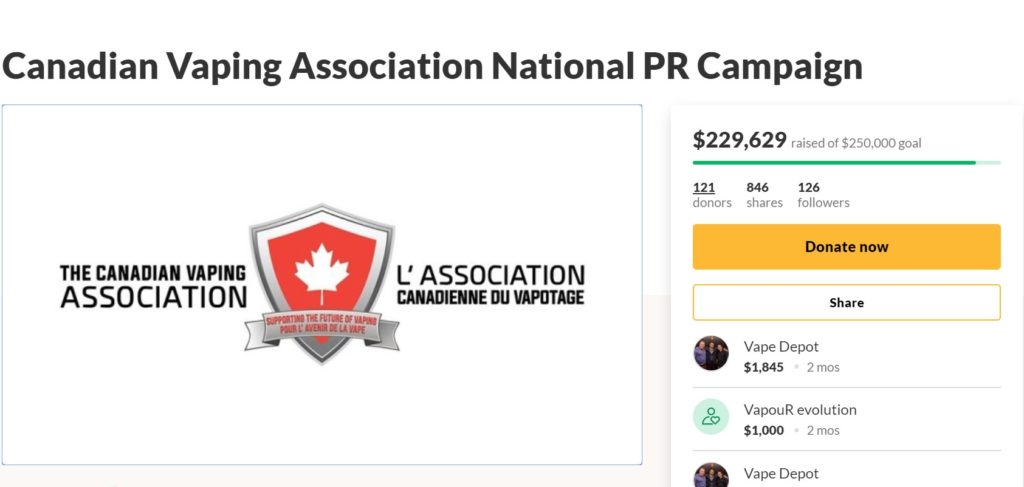
VITA and CVA both run public relation campaigns, but pursue different goals. VITA wants to promote the health benefits of e-cigarettes compared to tobacco. In order to do that, they try to lobby the federal government. The goal of CVA’s campaign is to avoid the ban on flavors.
According to Public Health Ontario review, between 2017 and 2018, among 16 to 19-year-olds, the prevalence of vaping increased in Canada and the US. Canada, the review claims, would experience greater increases in vaping due to the combination of regulatory change and the introduction of e-cigarettes containing nicotine salts into the market. The use of Juul, a nicotine salt based electronic cigarette with high nicotine concentration, increased in all countries, particularly the US and Canada.
Six Vapes is one of the many Vaping stores in Toronto. John, in his 30s, has worked for this shop since it was open in 2015.
“The Juul you can find everywhere, including convenience stores. It’s everywhere in the world, it’s the biggest company. Because of that, we need to have it, but it doesn’t mean it’s our most popular item. ”
“Convenience stores sell a few things; we sell a wider variety. So what’s popular any given moment, changes a couple of times a year”.
“When we opened back in 2015, the most popular products were freebase liquids, which are low nicotine liquids. They were these bigger you probably seen them, they produce large clouds. That’s a very different device from what is popular now. Nowadays, products come as refillable and not refillable items. For example, Juul is not refillable. You just buy the pods prefill, clicked them in and go. And then you choose your strength; you choose your flavor. ”
“Usually, our customers just want to know what they can have to stop smoking. So we ask them a bunch of questions, like how much they smoke, have they tried vaping before or not, what kind of experience they would want. Now it’s all about small convenient devices. But it obviously depends on your budget, so we ask how much do they want to spend on that. ”
“An average refillable device costs around 40 buck, the same is with Juul, depends on the promotion. But then there is the over time cost, the things you have to replace, pods first of all. You replace them every week or so. With Juul, you replace them every day or two. So there is more cost rather than buying a device initially. Things like the Juul that you don’t refill yourself are always more expensive over time. The average sale also changes over time. It’s used to be between 50 to 75, now it’s more 30 or 35. Remember, not everybody is buying a device every time. People can gram some pods or liquids. If they buy one pack, it’s 25, if they buy 2, it’s 50.”
The Ontario government has announced it will ban most flavored vaping products from convenience stores and gas stations. Nicotine levels also will be capped. The goal is to prevent young people from using e-cigarettes.
The new rules won’t apply to specialty adult-only vape shops. These shops require proof of age and sell only vaping products. Those stores will still be able to sell a variety of flavored products and e-cigarettes with higher nicotine content.

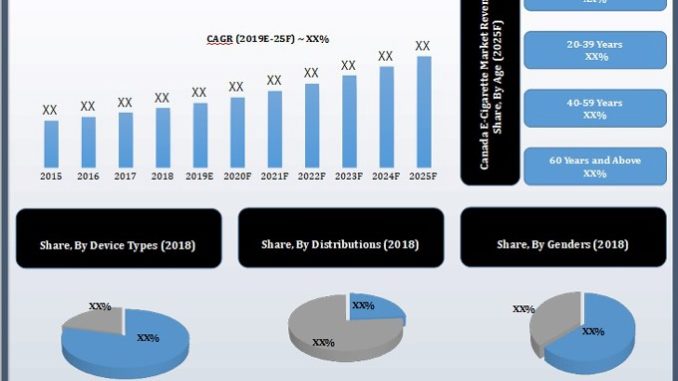
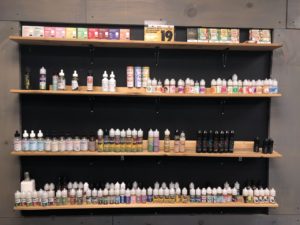
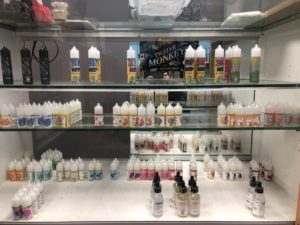
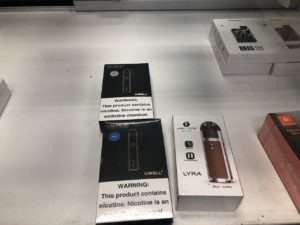
Be the first to comment